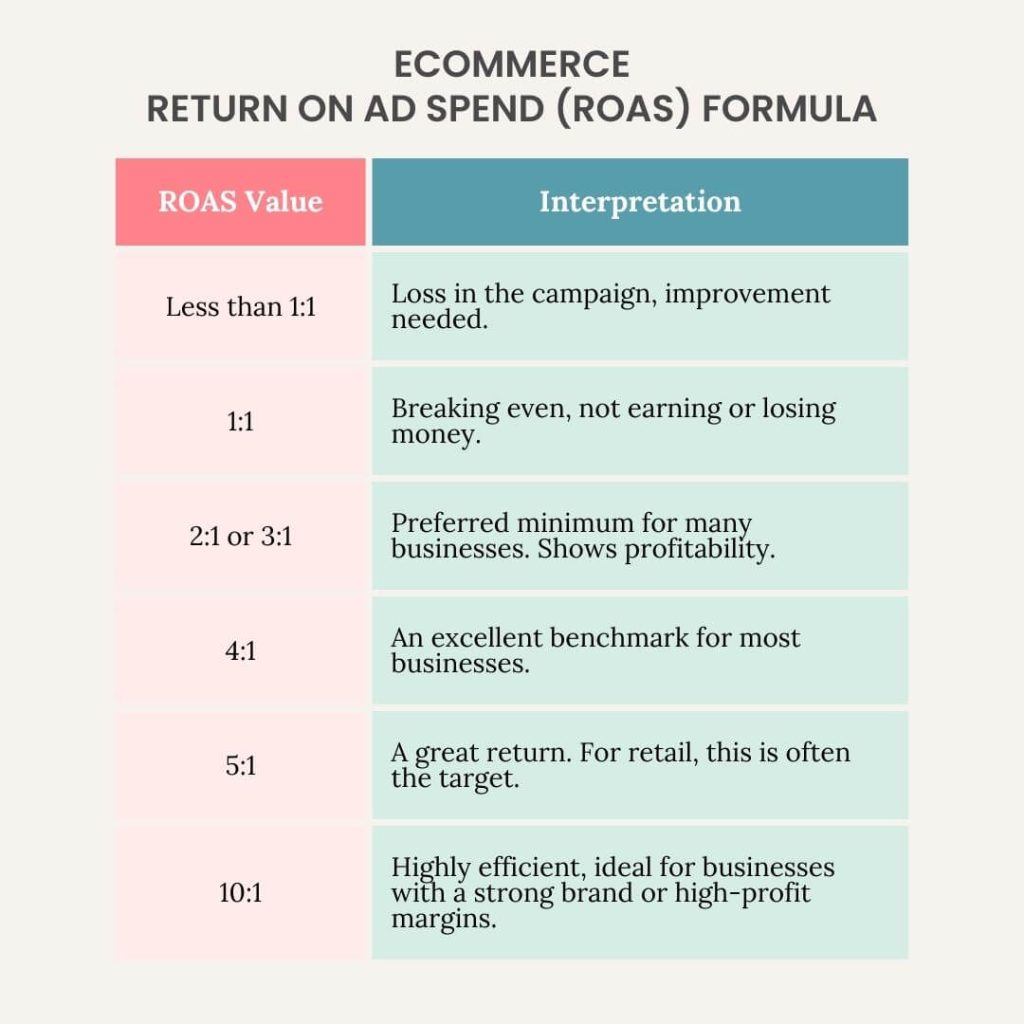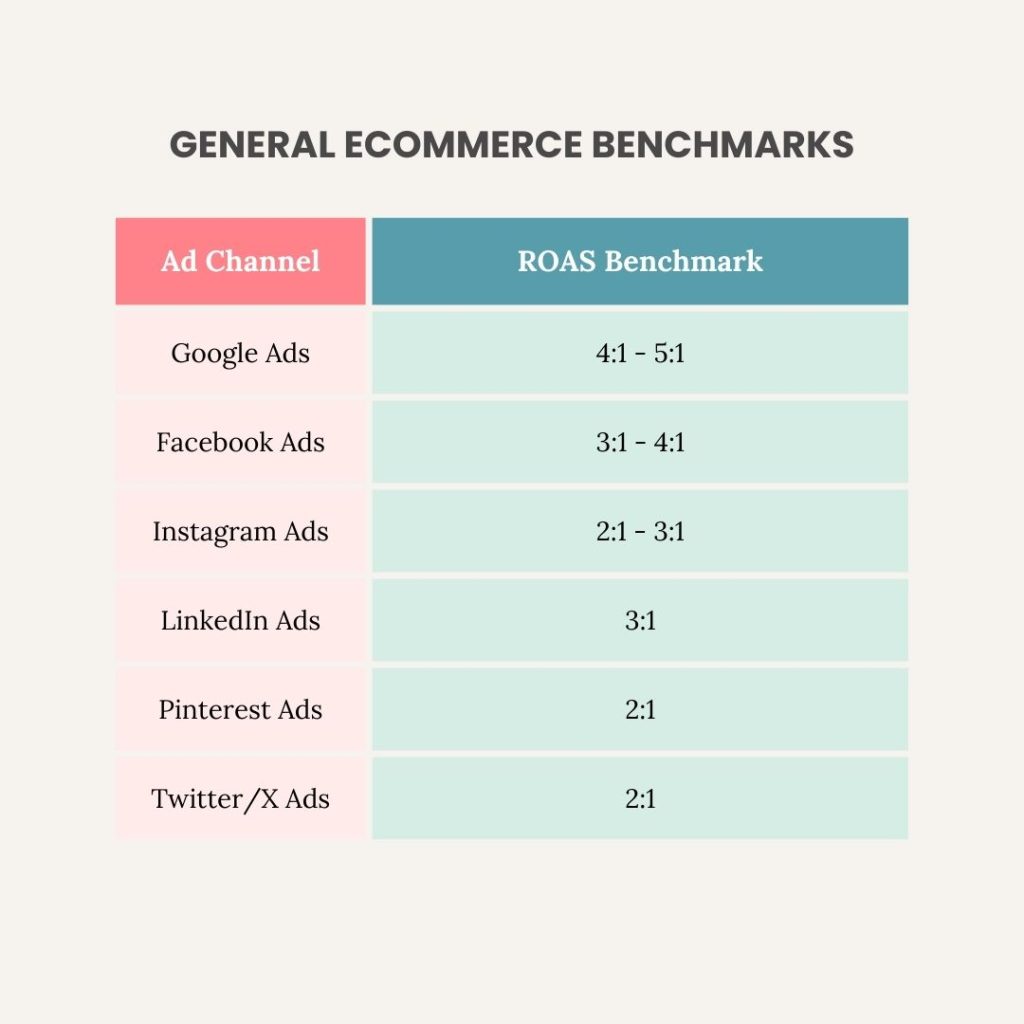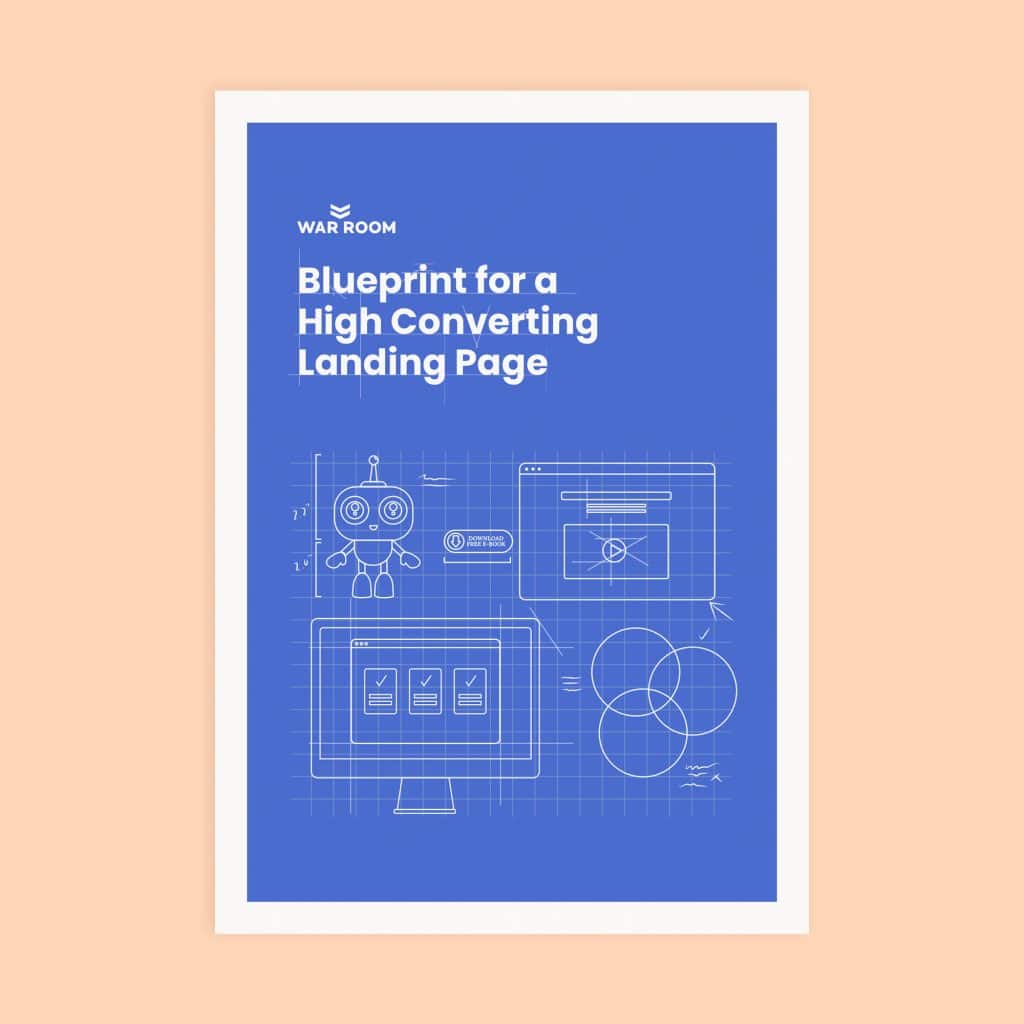As an ecommerce marketer, you’re always looking for ways to get more out of your online advertising budget.
The importance of focusing on Return on Ad Spend cannot be overstated; it’s the most critical metric that gauges the effectiveness of your advertising efforts. Increasing your ROAS means increasing your revenue and doing so with efficiency and strategic direction.
The ROAS formula is straightforward: divide your ad campaign’s total revenue by the total amount spent on the ad. This provides your return on ad spend (ROAS), an essential performance indicator. The table below should give you an idea of what a good ROAS for ecommerce is.

If you’re running an ecommerce business, it’s crucial to understand what a good Return on Ad Spend (ROAS) means for your particular sector and platform of choice. Essentially, the specific platform you use for your ecommerce enterprise may impact the ROAS you should aim for. Let’s dive into the benchmark data for each platform.

It’s important to note that these are general benchmarks. The ideal ROAS for your specific ecommerce business may vary based on a number of factors, including your industry, the quality of your products, and your target audience. Always track your ad spend and adjust your strategy to maximize your ROAS.
Improving your Return on Ad Spend (ROAS) isn’t about spending more but spending smarter. Here are some effective ways to give your ROAS a lift.
1. Reduce Your Ad Cost by Adjusting Your Facebook Bidding Strategy
It’s no secret that a vast majority of ecommerce businesses use Facebook ads as a critical part of their marketing strategy. One key aspect of Facebook advertising that can significantly impact your Return On Advertising Spend (ROAS) is bid strategy.

According to a report by Databox, an effective bid strategy is all about finding a balance between your campaign goals and budget. You can choose between automatic and manual bidding, each with its advantages. With automatic bidding, Facebook does the heavy lifting for you, optimizing your bids based on your budget and ad objective. On the flip side, manual bidding gives you more control, allowing you to choose how much you’re willing to pay for a certain action.
The choice between bid strategies largely depends on your knowledge of the platform and the flexibility of your budget. It’s clear that a strategic approach to Facebook ad bidding can do wonders in boosting your ROAS.
2. Improve Advertising Conversions With Relevant Landing Pages
When it comes to boosting your Return on Ad Spend (ROAS), achieving congruence between your ad’s call to action and your landing page is a game changer. This refers to the seamless alignment between the message in your ad and the follow-up content on your landing page. This consistency builds trust, and trust translates into more conversions, improving your ROAS.
Reflecting your ad’s promise on your landing page reassures customers that they’re in the right place and, more importantly, validates their decision to click on your ad. This way, you’re helping visitors through their buying journey, maintaining engagement, and boosting the probability of conversion.
Besides, personalizing landing page content based on the ad that led there can make the customer feel understood and valued, which increases their likelihood of converting and becoming a repeat customer. In other words, ad-landing page congruence is quintessential to creating a customer-centric e-commerce environment that drives a higher ROAS.
3. Utilize Dynamic Funnel Marketing to Target Customers Effectively
In the world of marketing, there’s a well-known principle called the rule of seven. What does it mean? Simply put, it’s a theory that potential customers need to see or interact with a brand’s ad seven times before they make the decision to purchase a product or service.
We’re living in an information overload age, making it increasingly difficult for brands to cut through the noise and capture a user’s attention. This is where repeated exposure comes into play – it’s not usually a single ad that convinces a customer to buy; rather, it’s the cumulative effect of seeing your brand over and over again.
For example, a customer can see your ad for your product, click on it -and if they don’t buy, they can be retargeted with a different ad geared towards getting their e-mail address in exchange for a coupon. Once they are on your e-mail list, you can show them different ads on Google, Facebook, and Instagram and reach them via e-mail marketing. Once you’ve optimized your funnel, you can increase ad spend and boost your ROI. A business generator AI can further enhance this process by automating personalized ad campaigns, increasing the efficiency of your retargeting efforts.
4. Implement Catalog Shopping Ads for a Streamlined Shopping Experience
Google Shopping Ads are a key player in the online ad space, specifically tailored for ecommerce businesses. They showcase your products directly in the search results, complete with product image, price, and merchant name. You need to perfect your optimization strategy to ensure your ads pop up in the right places and attract the right consumers.
So, what’s the best way to go about it? Drawing from Google’s own recommendations, here are five insightful and proven ways to optimize your Google Shopping ads:
First, focus on bid optimization. A proper bidding strategy is vital for your Google Shopping campaigns. You could use automated bidding strategies such as target return on ad spend (ROAS) or maximize conversion value. These strategies use machine learning to optimize your bids, helping you get the most out of your budget.
- Target ROAS: This strategy will set bids to help get as much conversion value as possible at your set target ROAS.
- Maximize Conversion Value: This bidding strategy aims to maximize the total conversion value for your campaign within your specified budget.
Secondly, the implementation of high-quality product data is key. Overlooking details in your product data can cost your performance in Google Shopping Ads. Ensure that your product titles, descriptions, and images are clear, relevant, and contain most of the search terms your customers might use.
Third, consider segmenting your products. One size does not fit all in ecommerce marketing. Different products have different margins and related business goals, so they may require different bids and budgets. That’s why it’s important to structure your campaigns and ad groups in a manner that allows for this kind of flexibility.
Next, focus on continuous testing and optimization. Google Shopping is both complex and dynamic, requiring ongoing management and optimization. Regularly review the performance of your campaigns, ad groups, and product groups, making tweaks or adjustments as necessary to increase ROAS.
Google Ads are a powerful tool for boosting ROAS in your ecommerce business. You can make the most of this tool by optimizing your bidding strategy, improving product data, segmenting products, and continuously testing and optimizing your campaigns.
Don’t overlook the potential of retargeting and remarketing as they can significantly amplify your results.
5. Explore Shoppable Posts to Enhance Customer Engagement
With the rise in digital marketing trends, we can’t neglect the significant impact of video content and how it’s revolutionizing Ecommerce. Shoppable video posts are one of these new-age techniques that can substantially enhance the Return on Ad Spend (ROAS) for your Ecommerce business. But, what exactly are shoppable video posts?
Shoppable video posts are interactive videos embedded with product links allowing viewers to make direct purchases within the video. This technique simplifies the buyer’s journey, creating a direct path from discovery to purchase. It’s an innovative way of not only engaging your audience with compelling content, but also empowering them to act instantly on their buying impulses.
Studies show that videos hold immense potential in attracting and retaining customers. Considering the shorter attention span of today’s internet user, video content seems to hit the right chord. Shoppable video posts serve as a seamless blend of entertainment and convenience. Viewers no longer have to go searching for a product they saw in a video – a simple click takes them right there!
So, how can shoppable video posts boost your ROAS? Here are a few reasons:
- Enhances User Experience: Shoppable video posts streamline the shopping experience for your customers by reducing the steps they need to take to make a purchase.
- Direct Sales Channel: By allowing customers to shop directly from the video, you create another sales channel that can increase revenue and higher ROAS.
- Boosts Brand Engagement: Engaging video content encourages customers to spend more time interacting with your brand, potentially leading to higher conversion rates.
- Improved Tracking: Shoppable video posts allow you to track customer interactions and engagements more refinedly, aiding in better decision-making for future campaigns.
Creating shoppable video posts can require a higher initial investment, but the potential returns are well worth it. It’s about making smart ad spends that captivate the audience and convert interests into sales, ultimately giving your Ecommerce business the ROAS boost it needs.
6. Engage in Cross-channel Ad Optimization for Consistency Across Platforms
Understanding cross-channel ad optimization is critical for boosting your Return on Ad Spend (ROAS) in your ecommerce business. This approach means managing your advertising efforts across multiple channels, like Google, Facebook, Instagram, and Amazon, to ensure a more well-rounded digital advertising strategy.
When you optimize your ads across these various channels, you’re not just targeting different audiences. You’re also maximizing the potential of each platform’s special features and audience preferences. It’s all about getting your message to the right people in the right place at the right time.
But there’s more; cross-channel ad optimization provides valuable insights and data that can be used to further enhance your advertising efforts. By analyzing how your ads perform across different channels, you can identify trends, strengths, and areas for improvement. This will enable you to tweak your strategies for better performance and, ultimately, higher ROAS. The direct resource that will show you all this is a marketing performance tracking tool, and you need to choose ones that will fit your budget, so you may use Saas pricing insights to gain an understanding of the costs in order not to overspend when your main goal is to increase the revenue.
So remember, to boost your ROAS, don’t put all your eggs in one basket. Make use of the various platforms at your disposal, optimize your ads across these channels, and analyze the data to further refine your strategy and maximize your return on investment.
7. Partner With Influencers to Expand Your Reach
Taking your ecommerce business to the next level involves many elements, including partnering with affiliate influencers. With the rise of social media, these influencers have become a powerful tool to boost Return On Advertising Spend (ROAS).
But what does this actually look like?
Imagine you were in the shoe business. After locating influencers who have a strong following in the fashion industry, you’d reach out to them for a partnership. In exchange for promoting your shoes to their followers, they would receive a commission on every sale they make. Not only does this drive traffic to your ecommerce site, but it also contributes to direct conversions and brand visibility.
So, how exactly can you initiate this process?
- First off, identify potential influencers in your niche. Look for those with a sizable following and a high level of engagement.
- Next, extend an appealing offer. This could be free products, a commission on sales, or even a fixed payment.
- Once you’ve partnered with the influencer, collaborate with them on promotional content that aligns with their brand and emphatically showcases yours.
Sure, setting up an affiliate influencer program requires time and effort upfront, but the potential return on investment makes it worthwhile. It’s a proven way to boost your ecommerce brand’s visibility, capture a wider audience, and, in turn, increase your ROAS.
Ready To Boost Your Ecommerce ROAS?
Great work! You’ve now learned how to take your ecommerce store to new heights by boosting ROAS! As marketers, it’s vital for us to understand the importance of analytics and PPC in driving results and reaching our goals. Advertising campaigns should be meticulously crafted and adjusted according to the data we gather, focusing on increasing the ROI.
Properly utilizing strategies such as email marketing can greatly enhance your customer lifetime value, offering untold benefits to your online venture. Our websites are more than storefronts—they’re platforms through which we actively engage with our customers and cultivate meaningful relationships that improve both personal and financial returns.
Always stay on top of your game. Get to know your analytics, fine-tune your PPC strategies, and don’t underestimate the power of robust advertising campaigns. With the right mindset and tools, you’re well on your way to achieving stellar ROAS for your ecommerce business.
















